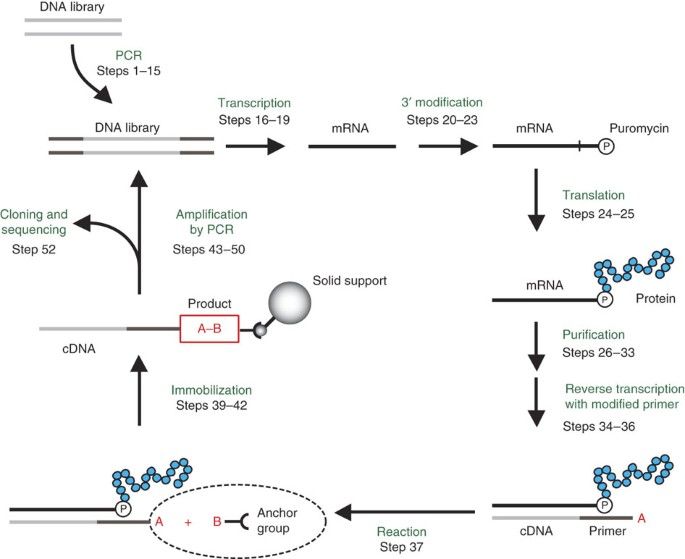mRNA Display-based Enzyme Directed Evolution is an advanced method that allows us to evolve proteins in vitro to obtain desired properties. This technique is a potent instrument in molecular biology and biotechnology, enabling us to utilize and enhance the natural process of evolution to develop proteins with enhanced or new functionalities. It provides a way to make proteins that do not exist naturally. By employing this technology, we can expand the limits of what is currently possible in protein engineering.
 mRNA display for the selection and evolution of enzymes from in vitro-translated protein libraries (Burckhard Seelig, 2011)
mRNA display for the selection and evolution of enzymes from in vitro-translated protein libraries (Burckhard Seelig, 2011)
Technical Route
Our approach to the mRNA Display-based Enzyme Directed Evolution process is meticulous, comprehensive, and focused on ensuring project success. It encompasses several vital steps, each playing a critical role in the overall process.
| Step |
Objective |
Description |
| Design and synthesis of mRNA-protein fusions |
Establish the structural basis for the protein evolution process. |
At this initial stage, we design and synthesize mRNA-protein fusions, laying the foundation for subsequent protein evolution. |
| In vitro translation and display of mRNA-protein fusions |
Activate and present the synthesized mRNA-protein fusions for selection. |
In this phase, mRNA-protein fusions are translated in vitro and put on display, ready for the selection process. |
| Selection of desired proteins |
This critical step involves identifying proteins that best meet selection criteria, ensuring only promising candidates advance. |
Determine proteins with desired characteristics, advancing them to the next phase. |
| Amplification of selected proteins |
Chosen proteins exhibiting promising traits are amplified, creating a pool of evolved proteins for further evaluation. |
Increase the quantity of selected proteins to enhance their representation and utility. |
| Analysis and validation of evolved proteins |
The final stage involves meticulous analysis and validation of evolved proteins to confirm their properties and functionality. |
Validate the functionality and suitability of evolved proteins, aligning with project goals. |
Service Process
Our comprehensive and meticulous process of service delivery unfolds over several significant stages, each of which is specifically designed to ensure the utmost customer satisfaction:
- Initial consultation and project planning: This is the stage where we sit down with you to discuss your project needs and objectives in detail. We work with you to understand what you aim to achieve, and plan the project accordingly, ensuring that we align our strategies with your expectations.
- Creation of a protein library: Following the initial planning, our experts generate a diverse library of proteins. This library serves as the foundation for the following evolution process, providing a rich pool of potential candidates for selection.
- Selection and amplification of desired proteins: At this juncture, the protein library is subjected to stringent selection pressures. Those proteins that best meet the selection criteria, demonstrating the desired characteristics, are then amplified. This strategic process ensures we identify and focus on the most promising proteins.
- Verification of protein properties: Once the proteins have been selected and amplified, the evolved proteins are thoroughly analyzed. This verification process is crucial to confirm their properties and functionality, ensuring they meet the project's objectives and standards.
- Delivery of final product and report: Upon completion, we provide you with the evolved proteins, along with a comprehensive report that details the entire process and its results. This report provides valuable insights into the evolution process and the characteristics of the final proteins.
We're here to assist you. If you have any questions, need more information, or would like to discuss a potential project, please don't hesitate to contact us. Our team is always eager to help and share our expertise.
Applications
| Application |
Description |
| Biocatalysis |
mRNA Display-based Enzyme Directed Evolution is extensively utilized in the field of biocatalysis, where it serves as a powerful tool for the creation and optimization of enzymes. By harnessing the power of mRNA Display-based Enzyme Directed Evolution, researchers are able to evolve enzymes with enhanced catalytic activity, selectivity, and stability, thereby enabling the development of highly efficient biocatalysts for a wide range of applications. |
| Pharmaceutical Research |
Within the realm of pharmaceutical research, mRNA Display-based Enzyme Directed Evolution offers a transformative approach to enzyme engineering, facilitating the discovery and optimization of enzymes for various drug-related processes. Enzymes play a vital role in drug synthesis, metabolism, and drug delivery, making them indispensable tools in pharmaceutical research and development. By employing mRNA Display-based Enzyme Directed Evolution, researchers can evolve enzymes with desired properties such as enhanced substrate specificity, improved stability, and altered catalytic activity, thereby enabling the development of novel therapeutic agents, optimization of drug manufacturing processes, and enhancement of drug delivery systems. From the discovery of new drug targets to the optimization of drug formulations, this innovative approach to enzyme engineering opens up new possibilities for pharmaceutical research, ultimately leading to the development of safer, more effective drugs for various medical conditions. |
| Industrial Biotechnology |
Industrial biotechnology, which involves the use of biological systems and processes to produce goods and services, relies heavily on enzymes for a wide range of applications including food production, biofuel manufacturing, textile processing, and waste treatment. mRNA Display-based Enzyme Directed Evolution plays a crucial role in industrial biotechnology by enabling the development of enzymes tailored to specific industrial processes and applications. Whether it's the production of high-value chemicals, the conversion of renewable feedstocks into biofuels, or the treatment of industrial waste, this innovative approach to enzyme engineering offers a powerful solution to the challenges faced by the industrial biotechnology sector. |
| Environmental Remediation |
Enzymes play a key role in environmental remediation by facilitating the degradation of various pollutants and contaminants. mRNA Display-based Enzyme Directed Evolution enhances environmental remediation efforts by enabling the development of enzymes with enhanced biodegradation capabilities. Whether it's the cleanup of oil spills, the removal of heavy metals from soil, or the detoxification of industrial wastewater, this innovative approach to enzyme engineering offers a sustainable and cost-effective solution to environmental pollution. |
| Agricultural Biotechnology |
In the field of agricultural biotechnology, mRNA Display-based Enzyme Directed Evolution plays a crucial role in the development of enzymes for various agricultural applications, including crop protection, soil improvement, and plant biotechnology. Enzymes are essential for numerous processes in plants, including nutrient uptake, defense against pests and diseases, and synthesis of important molecules such as carbohydrates and proteins. By harnessing the power of mRNA Display-based Enzyme Directed Evolution, researchers can evolve enzymes with enhanced activity, specificity, and stability, thereby improving crop yield, quality, and resilience to environmental stresses. Whether it's the development of enzymes for pest resistance, the enhancement of nutrient use efficiency, or the improvement of soil health, this innovative approach to enzyme engineering offers novel solutions to the challenges facing modern agriculture. |
FAQs
Display-based Enzyme Directed Evolution, which covers basic understanding, importance, process, applications, and other key aspects of this advanced molecular biology technique. If you have more specific or detailed questions, don't hesitate to get in touch with us directly.
Q: What is mRNA Display-based Enzyme Directed Evolution?
A: mRNA Display-based Enzyme Directed Evolution is an advanced molecular biology technique that allows for the in vitro evolution of proteins to acquire desired properties. It involves creating a protein library and subjecting it to selection pressures, followed by amplification of the selected proteins.
Q: Why is it important to study this technique?
A: This technique allows us to create proteins with improved or completely new functionalities. It provides a new avenue for protein engineering, opening up possibilities for drug development, diagnostics, and enzyme engineering.
Q: How does the process work?
A: The process involves creating a protein library, subjecting it to selection pressures, and then amplifying the selected proteins. It utilizes the natural process of evolution but in a controlled, in vitro setting.
Q: What are some potential applications?
A: The potential applications are vast and include drug development, diagnostics, and enzyme engineering. It can also be used in other areas of biotechnology and molecular biology.
Q: Is mRNA Display-based Enzyme Directed Evolution safe?
A: Yes, it is a safe and well-established technique used by researchers globally.
Q: What are the benefits of using mRNA Display-based Enzyme Directed Evolution?
A: The technique allows for the creation of proteins with improved or completely new functionalities. This can lead to the development of innovative medical treatments, diagnostics, and industrial applications.
Q: How long does the process take?
A: The length of the process can vary depending on the specific project and objectives. It can range from a few weeks to several months.
Q: Is the process cost-effective?
A: Yes, the process can be cost-effective, especially when compared to traditional methods of protein engineering. It enables more precise control over the evolution of proteins, potentially reducing the time and resources required for protein engineering projects.
Q: Can the process be customized to meet specific needs?
A: Absolutely, the process can be tailored to meet the specific needs and objectives of each project. We work closely with our clients to ensure that the process aligns with their goals.
Q: How can I learn more about mRNA Display-based Enzyme Directed Evolution?
A: We encourage you to contact us to learn more about this innovative technique and how it can benefit your research or business.

































 mRNA display for the selection and evolution of enzymes from in vitro-translated protein libraries (Burckhard Seelig, 2011)
mRNA display for the selection and evolution of enzymes from in vitro-translated protein libraries (Burckhard Seelig, 2011)